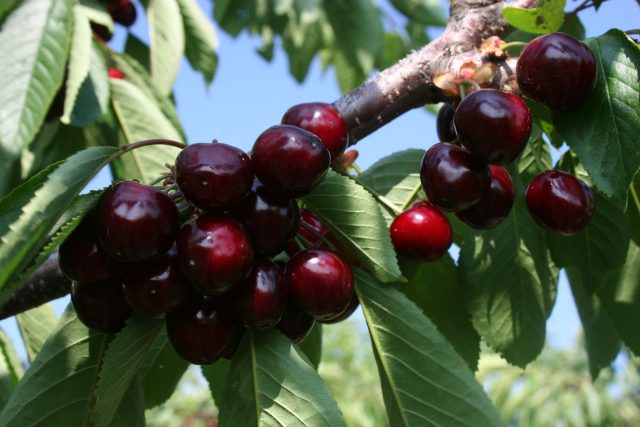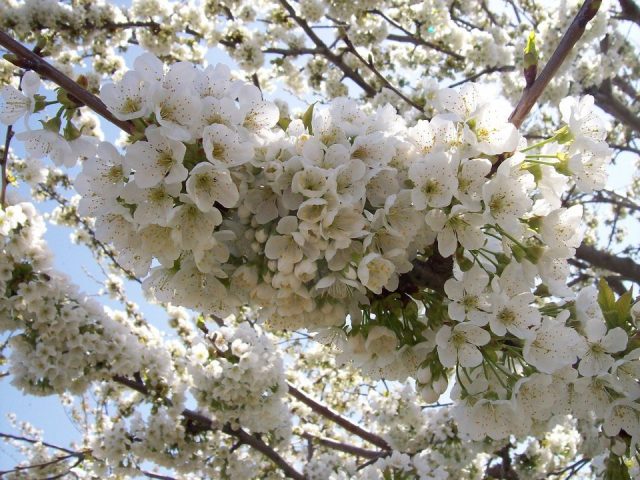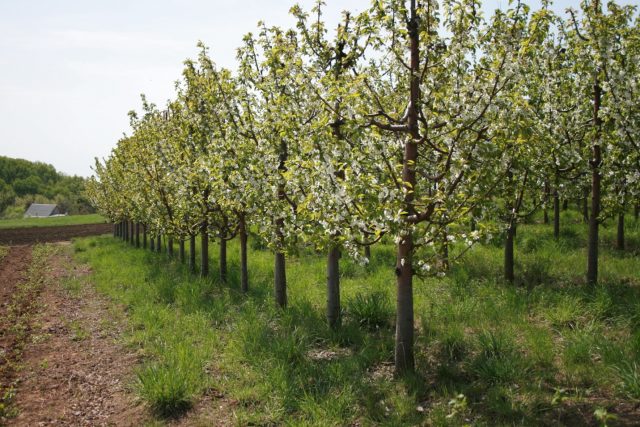Content
Cherry Raditsa is an excellent variety with high yields. Being a very thermophilic fruit tree, it is very demanding on climatic conditions and soil. Raditsa is hard to endure winters with little snow and strong frost, so it often freezes over. At the same time, the capriciousness of cherries is compensated by a rich harvest of large, juicy and incredibly sweet fruits.
Breeding history
The Raditsa variety was obtained by crossing Kommunarka and Leningrad black at the All-Union Research Institute of Lupin by the famous breeder M.V. Kanshina. In 2001, it was entered into the State Register of Breeding Achievements. Experts recommend planting cherries in the Central Region.
Description of culture
Cherry Raditsa is a rapidly growing, beautifully leafy tree of medium height, endowed with a wide, rounded crown of moderate density.
The kidney is large, vegetative, cone-shaped, strongly deflected, generative.
Cherry leaves Raditsa are obovate, elongated, medium-sized, bright green in color, with a pointed tip, have a round base. The leaves are serrated, the plate is straight, the pigmented petiole is medium in size, has 2–3 glands each.
Each inflorescence contains three medium flowers (petals slightly overlap each other, snow-white in color, stigma of the pistil is at the same level with anthers, cup is glass-shaped, stamens and pistils are elongated). Fruiting is usually concentrated on bouquet branches (60%).
The size of the ripe berries of the Raditsa cherry, which ranges from 4.6 to 5.7 g, is considered to be average. The fruit is oval in shape, with a voluminous funnel and a rounded top, rich burgundy hue, almost black; the flesh is dark red, with moderate firmness. The stone is beige in color, accounting for 5.2% of its weight, it is easily separated from the pulp. Ripe cherry berries Raditsa are very sweet (11.2% of sugars), with a barely noticeable sourness (0.4%). 100 g of product contains approximately 13.5 mg of ascorbic acid. The taste of the berries is excellent, ripe fruits do not crack.
Characteristics
The characteristics of the Raditsa cherry variety are quite attractive for gardeners.
Saplings of the Raditsa variety grow rapidly, the height of the Raditsa cherry tree is about 4 meters. In tests carried out at an air temperature of 29 to 34 degrees below zero, an adult plant was frozen by only one and a half points.
Drought resistance, winter hardiness
The Raditsa variety is not drought-resistant. Cherry loves watering and requires it regularly, while categorically does not tolerate stagnant water, and because of the excess liquid, ripe berries can burst during ripening.
Before winter, it is worthwhile to make a water-charging make-up. Adult plants are watered several times during the growing season, in autumn - once a week.
Frost resistance of Raditsa cherry is moderate. The plant easily tolerates low temperatures under the snow, but young seedlings must be protected from frost in severe winters with little snow.
Pollination, flowering period and ripening times
Cherry Raditsa is a self-fertile variety. The best pollinators for Raditsa cherries:
- Jealous;
- Iput;
- Tyutchevka.
Productivity, fruiting
Raditsa is a sweet cherry variety with high yield rates. Fruits of a bright ruby hue ripen in unison by the beginning of summer. An adult sweet cherry begins to bear fruit at 4–5 years of age. On one hectare of plantations, the Raditsa sweet cherry is capable of bringing an average of 60 centners of a rich harvest.
Scope of berries
Ripe fruits of the early Raditsa cherry can be consumed fresh, cook juices, compotes, tinctures, preserves, jellies; also the berries are frozen, candied and dried.
Sweet cherries are able to have a mild diuretic and laxative effect on the body, as well as help to normalize the work of the intestinal tract. Experts advise eating cherry berries for stomach ulcers and duodenal ulcers, as well as for gastritis.
Disease and pest resistance
Cherry variety Raditsa is resistant to coccomycosis and moniliosis, as well as to clasterosporiosis. The plant has almost one hundred percent immunity to the first two diseases, but the possibility of being affected by clasterosporiosis is 50%.
Advantages and disadvantages
The main advantages of the Raditsa variety are:
- high productivity;
- sweet large fruits;
- moderate frost resistance;
- versatility in use;
- immunity to major diseases affecting plants of this species.
Disadvantages:
- high trunk height, which makes it difficult to collect fruits;
- lack of drought resistance;
- self-infertility.
Landing features
Before planting a Raditsa cherry seedling, its roots should be placed in the Kornevin solution for half a day. After that, the young tree needs to be examined carefully, getting rid of the damaged areas of the rhizome.
- A stake is driven into the recess.
- The seedling is lowered onto an earthen cone on the south side of the hammered stake.
- The roots must be straightened so that they do not curl, sprinkle the seedling with earth.
Recommended timing
A pit-shaped landing site should be prepared in the fall. Young seedlings are placed in the ground in early spring, almost immediately after the snow melts, but until the buds swell.
Choosing the right place
Planting and caring for Raditsa cherries, done in a competent manner, is the key to healthy plants and a bountiful harvest.
Raditsu is recommended to be planted in a sunny place, sheltered from strong winds.
The second condition is moderate acidity of the soil.
In the event that the soil has high acidity, you need to sprinkle it with lime or dolomite flour and dig up the soil. After a couple of weeks, at a distance of 3 m from each other, they dig holes for planting: 0.8 m wide, 0.5 m deep, mixing several buckets of compost or humus with the top layer of earth. In the spring, it is required to fill the pit with 1 kg of ash, and then form a cone from the resulting mixture at the very bottom.
What crops can and cannot be planted next to cherries
Well-chosen neighbors will have a beneficial effect on the growth and development of young cherries (for example, they will protect them from diseases and pests), while some plants can cause irreparable damage to Raditsa (growth is inhibited, seedlings begin to ache and wither).
When planting young Raditsa cherries in the garden, you should not place them close to the following plants:
- apple trees (can be planted keeping a distance);
- raspberries, gooseberries (plants have a superficial root system: the bushes take the most useful substances from the upper layers of the soil, which slows down the development of neighboring fruit trees);
- sea buckthorn (a plant endowed with a developed and powerful root system is capable of oppressing its neighbors, preventing the successful formation of their roots);
- plants from the nightshade family (tomatoes, eggplants, tobacco): they can become a focus of verticillus wilt (a disease that affects the wood of a tree, as a result of which it begins to wither and eventually dies).
Plants are capable of having a positive effect on a young seedling:
- cherries and cherries of other varieties (pollinators);
- cherry plum and plum trees (able to protect against diseases and pests);
- elderberry (excellent protection against aphids);
- grapes;
- honeysuckle.
Selection and preparation of planting material
- When choosing a Raditsa cherry seedling, first of all you need to make sure whether it has a vaccination site. This sign indicates that the tree is varietal.
- The smooth barrel diameter must be greater than 17 cm.
- A healthy biennial plant should have at least four branches, each of which is 40 cm.
- The rhizome should not be dry.
Before planting in the ground, it is required to rid the trunk of leaves in order for the nutrient components to be consumed evenly, in the correct way.
Landing algorithm
The cultivation of Raditsa cherries requires a careful approach and the implementation of an algorithm of sequential actions.
- When planting, the cherries must be raised so that the root collar is at least 4 cm above the ground.
- The trunk of the tree is tied to a stake, forming an eight from the ribbon so that the trunk is not damaged during the growth process.
- A hole is formed near the trunk, pouring a roller of soil around the circumference and pouring several buckets of water under each tree.
- On top you need to put mulch from peat or humus.
Follow-up care of the culture
In order for the Raditsa cherry to please with its fertility and appearance, it is required to provide high-quality care:
- it is necessary to feed a young plant only in the second year of growth (until that time, useful minerals and fertilizers introduced into the hole during planting are quite enough for it);
- in the middle of spring, the tree is fertilized with nitrogen;
- preparation for frost should begin in the fall;
- to obtain a rich harvest, it is required to enrich the soil under the cherry green manure: lupine, sainfoin and vetch;
- to attract bees around cherries, you can sow mustard and phacelia, and in the fall, mow them and tamp them into the ground;
- in the year of planting, special attention should be paid to weeds;
- after a while, the near-stem distance should be expanded to 1 meter, gradually adding 50 cm each and removing unnecessary vegetation.
Diseases and pests, methods of control and prevention
Key pest control measures include the following:
- from aphids, cherries are sprayed with "Confidor" until the buds swell and after two weeks. You can also eliminate parasites with a solution of tobacco dust (soap can be added to its composition to adhere to the leaves);
- to get rid of cherry flies, sticky yellow plastic traps are placed on the trees before the flower buds open;
- it is customary to spray plants from moths with "Nitrofen";
- in order to protect trees from birds, nets are thrown over the crown.
Conclusion
Cherry Raditsa is a worthy variety for the central region. Already four years after planting, the plant begins to bear fruit and produces a large number of large juicy fruits. The dessert qualities of Raditsa berries make them versatile for sale. The variety is immune to most cherry diseases. Caring for cherries, carried out in a competent manner, contributes to obtaining a bountiful harvest.
Testimonials















